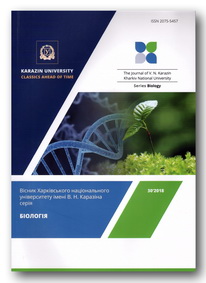Formation and self-maintenance of the population Hyssopus officinalis L. in conditions of the iron ore dump of Krуvyі Rih area
Abstract
We ascertained the features of formation of self-renewing and self-sustaining of the local population of the Mediterranean introducent Hyssopus officinalis L. in the extremal ecologic and edaphic conditions of an iron ore dump in Kryvyi Rih Area, seeds of which have been sown on the area of 1 ha about 30 years ago. It was found that the species, during this period after reaching the reproductive phase of development, has taken the area of the dump of about 3 ha and, in fact, it formed the isolated population. This species annually multiplied by seed, and spread on the areas of ore dump, where almost no vegetation cover, in fact, performing a pioneer function. At the site, where the initial sowing of H. officinalis seeds was carried out, the phytocoenosis forms now; this phytocoenosis, according to its floristic composition, approaches the natural steppe, but the introduced species are gradually ousted. In habitats occupied by the species due to its spontaneous distribution, successional processes are at an initial stage. Within some of the population loci of H. officinalis, we have found up to 513 adult individuals with the number of generative sprouts from 20 to 70 per a plant. Flowers are formed on these sprouts in average from 160.2 to 181.6. Average seed productivity is 60 % of theoretically possible rate, and the seeds from the parent species extend to a distance of 1–5 m. In a compact areas where H. officinalis grows, there are plants of all the age groups – from the seedlings to the subsenile. H. officinalis has naturalized in the dump conditions, and its local population is а resistant, full-grouped; it develops under the conditions where other species are not competitive. Generatively developed plants are higher than 90 cm and have good vital state. The species on the dump shows pioneering features; it is not aggressive and can be displaced by zonal vegetation; thus, it does not pose invasion risk. H. officinalis can be recommended for the revegetation of iron ore dumps, or their large decommissioned areas, without technical preconditioning, only by direct sowing of the seeds into the dump rocks, to promote its spread artificially.
Downloads
References
Afanasyev D.Ya., Bіlyk G.І., Bradis Ye.M., Gryn F.O. (1956). Classification of vegetation of the Ukrainian Soviet Socialist Republic. Ukrainian Botanical Journal, 13(4), 82–83. [In Ukrainian]
Boyko A.V., Ostapko V.M., Prikhodko S.A., Mulenkova Ye.G. (2012). Floristic finds in South-East of Ukraine. Industrial Botany, 12, 107–110. [In Russian]
Voronina Ye.P., Godunov Yu.N., Godunov Ye.O. (2001). New aromatic plants for Nechornozemya. Moscow: Nauka. 173 p. [In Russian]
Zhilyaev G.G. Viability of plant populations. – Lviv, Publishing House of LDPM NASU, 2005. – 304 p. [In Russian]
Zlobin Yu.A. (1989). Principles and methods of studying coenotic plant populations. Kazan: Publishing House of Kazan State University. 146 p. [In Russian]
Korshikov I.I., Krasnoshtan O.V. (2012). Viability of woody plants on the Krivoy Rog iron dumps. Donetsk: Digital Printing House. 280 p. [In Russian]
Kotyuk L.A., Rakhmetov D.B. (2012). Introduction of Hyssopus officinalis L. in the botanical garden of Zhytomyr National Agroecological University. Scientific Bulletin of the National University of bioresources and nature management of Ukraine. Ser.: Forestry and Ornamental Horticulture, 171(1), 101–105. [In Ukrainian]
Kotyuk L.A. (2015). Ontomorphogenesis of Hyssopus officinalis L. in conditions of introduction in the botanical garden of ZNIAU. Modern Phytomorphology, 7, 135–146. https://doi.org/10.5281/zenodo.160381 [In Ukrainian]
Lyubishchev A.A. (1986). Variance Analysis in Biology. Moscow: MGU. 199 p. [In Russian]
Mazur A.Yu., Kucherevsky V.V., Shol G.N. et al. (2015). Biotechnology of recultivation in the iron-ore waste by creation of stable herbaceous plant communities. Science and Innovation, 11(4), 41–52. https://doi.org/10.15407/scin11.04.041 [In Ukrainian]
Малиновский К.А., Царик И.В., Жиляев Г.Г. (1988). О границах природних популяций растений. Журнал общей биологии, 49(1), 5–12. [Malinovsky K.A., Tsarik I.V., Zhilyaev G.G. (1988). About the boundaries of natural plant populations. Journal of General Biology, 49(1), 5–12./ [In Russian]
Plugina T.V., Chayka V.Ye., Chuprina T.T. (1981). Natural and artificial overgrown dumps of Kryvbas. Ukrainian Botanical Journal, 38(4), 76–77. [In Ukrainian]
Field Geobotany (1976). / Ed. E.M.Lavrenko. Moscow, Leningrad: Nauka. Vol.5. 320 p. [In Russian]
Tsaryk J.V. (2007). The problem of viability of populations. Biological Studios, 1(1), 65–72. [In Ukrainian]
Shibko A.N. (2011). Biomorphological features of Hyssopus officinalis L. seeds cultivated in the conditions of Piedmont Crimea. Scienitfic Notes of TNU of V.I.Vernadsky. Ser. Biology, Chemistry, 24/63(4), 371–377. [In Russian]
Authors retain copyright of their work and grant the journal the right of its first publication under the terms of the Creative Commons Attribution License 4.0 International (CC BY 4.0), that allows others to share the work with an acknowledgement of the work's authorship.




